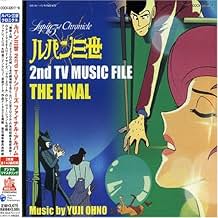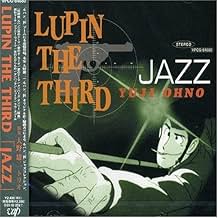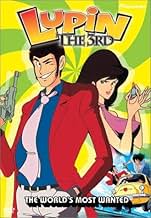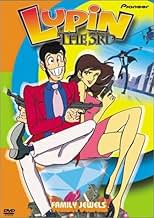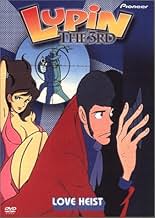AVALIAÇÃO DA IMDb
8,0/10
2,1 mil
SUA AVALIAÇÃO
O mestre ladrão Lupin III e seus companheiros continuam suas façanhas de controle global, com o teimoso inspetor Zenigata sempre atrás deles.O mestre ladrão Lupin III e seus companheiros continuam suas façanhas de controle global, com o teimoso inspetor Zenigata sempre atrás deles.O mestre ladrão Lupin III e seus companheiros continuam suas façanhas de controle global, com o teimoso inspetor Zenigata sempre atrás deles.
Explorar episódios
Avaliações em destaque
The first 'Lupin' series from 1971 is an anime, and animation, landmark and is still a great show in its own right and a good demonstration of what is so appealing about the Lupin franchise in the first place.
It was inevitable that there would be another show, and a series of films, that would follow, and the second 'Lupin' series is a very worthy one. It is not as big a landmark as the 1971 incarnation, which was always superbly written, entertaining and even suspenseful, actually really admired the darker and grittier tone of the earlier episodes, which more than made up for the ill-fitting and out-of-date music. With that being said, 'Lupin the III: Part II' does have more polished animation quality and much better music scoring that fits much better and sounds more appealing, plus its tone for anybody more familiar with the films is likely to be more accessible.
'Lupin the III: Part II' is not perfect. Do have to agree that a lot of the modern day jokes in the American/English dub are really jarring and anachronistic, and whether they're successful in being funny wildly varies (some are entertaining, others pretty cringe-worthy and distract badly). Things can be wildly implausible in the earlier episodes, with action that is admittedly well-animated and exciting but throws logic out the window.
However, as said, the animation is more polished this time round. There is more refinement in the drawings, more vibrant colouring, bolder and more meticulous background details and it looks more imaginative in general. The music score, again as aforementioned, is a much better fit and is more dynamically scored with a real liveliness, cool vibe and lushness.
Writing is incredibly funny, very smart and also very intelligent, while the action even with the implausibility is really exciting and often beautifully and imaginatively animated. The stories entertain and intrigue, with a real sense of adventure, fun, charm and suspense. Nothing's too simplistic and nothing's convoluted.
Great characters too, with a likable and interesting titular character who has both a fun and gritty side that stops him from being a one-dimensional stereotype. Of the supporting characters, Zenigata is my favourite, the conflict engrosses between the two and the character is just very well-written in his own right. The voice acting is good.
In conclusion, very good series. 8/10 Bethany Cox
It was inevitable that there would be another show, and a series of films, that would follow, and the second 'Lupin' series is a very worthy one. It is not as big a landmark as the 1971 incarnation, which was always superbly written, entertaining and even suspenseful, actually really admired the darker and grittier tone of the earlier episodes, which more than made up for the ill-fitting and out-of-date music. With that being said, 'Lupin the III: Part II' does have more polished animation quality and much better music scoring that fits much better and sounds more appealing, plus its tone for anybody more familiar with the films is likely to be more accessible.
'Lupin the III: Part II' is not perfect. Do have to agree that a lot of the modern day jokes in the American/English dub are really jarring and anachronistic, and whether they're successful in being funny wildly varies (some are entertaining, others pretty cringe-worthy and distract badly). Things can be wildly implausible in the earlier episodes, with action that is admittedly well-animated and exciting but throws logic out the window.
However, as said, the animation is more polished this time round. There is more refinement in the drawings, more vibrant colouring, bolder and more meticulous background details and it looks more imaginative in general. The music score, again as aforementioned, is a much better fit and is more dynamically scored with a real liveliness, cool vibe and lushness.
Writing is incredibly funny, very smart and also very intelligent, while the action even with the implausibility is really exciting and often beautifully and imaginatively animated. The stories entertain and intrigue, with a real sense of adventure, fun, charm and suspense. Nothing's too simplistic and nothing's convoluted.
Great characters too, with a likable and interesting titular character who has both a fun and gritty side that stops him from being a one-dimensional stereotype. Of the supporting characters, Zenigata is my favourite, the conflict engrosses between the two and the character is just very well-written in his own right. The voice acting is good.
In conclusion, very good series. 8/10 Bethany Cox
With the main problem being the lackluster, progressive cartoonification of the traits of the characters from the first part, being that of Rupan Sansei progressively becoming less and less a gentleman's thief and more a stupid's thief who throws away a fortune for a billionaire groupie, Fujiko Mine (who, incredibly enough, is the only one showing proper thievery, crime skills, guts and intelligence amongst all the Rupan Sansei group) progressively and forcibly presented as ONLY interested in monetary gain and nothing else and when she doesn't show that is reprimanded because of 70's sexism, Jigen is slowly reduced to a caricature spouting misoginyst lines who the facto does not act as a misogyn because reasens and Goemon is out there doing stuff. And unfortunately, by season three, the writing which in season one and two was pretty good turned from acceptable to bad to godawful with a whole slew of badly written, nonsensical episodes where things happened with no resonance whatsoever, with the only saving point of again showing the intelligence of the real leader of the Rupan Sansei gang (you guessed it, her name being Fujiko Mine) and nothing else. I was onboard with the idea of throwing the characters in more out-of-this world, wacky situations a là Silver Age but not at the expense of bad writing and ridiculization of their main characteristics. My rating for this series is 8 for the first two seasons and 5 for the third one, which I dropped by episode 89, hence a generous 7. I won't bother with the fourth season.
The first episode of the series re-unites Japan's favorite comic felon with his gang: crack shot Jigen, steely samurai Goemon and devious ex- girlfriend Fujiko on a cruise that turns out to have a surprise party scheduled just for them! The action moves on through a dizzying blur of international hot spots as the gang attempt one wildly improbable heist after another, usually with unexpected results. Past enemies from the earlier TV show make return appearances, and the Loch Ness Monster has a guest spot. The series creators stick closely to manga artist Monkey Punch's distinctive Sergio Aragones-influenced cartoon style, which is both a plus and a minus; everything has a uniform kookiness that can sometimes be distracting, especially when the setting requires a posh look.
In addition to the elaborate heists which characterize the series, occasional episodes go seriously weird and mystical, with lots of mind- bendingly surreal elements: telepaths, beams that induce suicide, a nun who deals in mass hypnosis (!) to name a few. Series villains often sport the towering arrogance and ambitions of James Bond supervillains.
This series really hit its stride in the second season with a run of truly fine episodes. Great heist action, elaborate chases, exotic locations and outrageousness are all featured here as Lupin's gang tries to recover Peking Man's Bones, steal a golden lion from the Australian government, rob a casino and finally steal the crown jewels of England. This final episode is the best of the disc as Lupin disrupts a royal wedding to get a crack at her majesty's crown!
Fast moving, with good looking action animation and well written (if often wildly implausible) heist schemes, untimely double-crosses and good background art depicting the globe scattered locations, there is lot here to enjoy.
In addition to the elaborate heists which characterize the series, occasional episodes go seriously weird and mystical, with lots of mind- bendingly surreal elements: telepaths, beams that induce suicide, a nun who deals in mass hypnosis (!) to name a few. Series villains often sport the towering arrogance and ambitions of James Bond supervillains.
This series really hit its stride in the second season with a run of truly fine episodes. Great heist action, elaborate chases, exotic locations and outrageousness are all featured here as Lupin's gang tries to recover Peking Man's Bones, steal a golden lion from the Australian government, rob a casino and finally steal the crown jewels of England. This final episode is the best of the disc as Lupin disrupts a royal wedding to get a crack at her majesty's crown!
Fast moving, with good looking action animation and well written (if often wildly implausible) heist schemes, untimely double-crosses and good background art depicting the globe scattered locations, there is lot here to enjoy.
I'm not a huge fan of anime, but for some reason, I love Lupin. Ever since it premiered on Adult Swim back in January, I've gotten a huge liking for it. Plus, it's so darn entertaining!!!
The cool thing about this show is how Lupin, and company in each episode always encounter a bad guy who may have something involved with what they're after. Of course to add more trouble is the restless Interpol inspector Zenigata whose been after Lupin for 7 years. In between these factors is off the wall antics, sexual themes, and lots, and LOTS of cleavage(courtesy of Fujiko).
Overall I like the show. It's pretty appealing, and it won me over from day one. If you've never seen this show, I suggest you check it out. You may like it.
P.S. Fujiko is HOT for a cartoon!
The cool thing about this show is how Lupin, and company in each episode always encounter a bad guy who may have something involved with what they're after. Of course to add more trouble is the restless Interpol inspector Zenigata whose been after Lupin for 7 years. In between these factors is off the wall antics, sexual themes, and lots, and LOTS of cleavage(courtesy of Fujiko).
Overall I like the show. It's pretty appealing, and it won me over from day one. If you've never seen this show, I suggest you check it out. You may like it.
P.S. Fujiko is HOT for a cartoon!
Most people in the US get acquainted with the Lupin III series via Hayao Miyazaki's debut film, The Castle of Cagliostro (1979) or this 1977 TV series which briefly aired on Adult Swim a few years ago. While it never made a hit on Adult Swim, this series was a smash in the late 1970s, the result of the franchise's renewed popularity which came from reruns of the 1971 Lupin anime.
Personally, I prefer the 1971 Lupin anime to this later incarnation. Despite the super limited animation and uneven tone over the 23 episodes, it broke more ground, feels more adult, and is less repetitive. However, that does not mean the second Lupin TV series is not worth your time. It's a fun, goofy romp of a show, one that can prove addictive if you're craving insane humor and quasi-surreal action. Yuji Ohno's soundtrack is superb, the essence of 1970s cool.
Also, the Geneon English dub isn't half bad. All the voice actors do their characters justice and seem to be having fun. This is a good series, one that deserves more than the lukewarm reception it received in the States.
Personally, I prefer the 1971 Lupin anime to this later incarnation. Despite the super limited animation and uneven tone over the 23 episodes, it broke more ground, feels more adult, and is less repetitive. However, that does not mean the second Lupin TV series is not worth your time. It's a fun, goofy romp of a show, one that can prove addictive if you're craving insane humor and quasi-surreal action. Yuji Ohno's soundtrack is superb, the essence of 1970s cool.
Also, the Geneon English dub isn't half bad. All the voice actors do their characters justice and seem to be having fun. This is a good series, one that deserves more than the lukewarm reception it received in the States.
Você sabia?
- CuriosidadesThe series, more parody-based than its predecessor, has referenced/satirized a number of international celebrities, such as Alan Delon, Pele, Jacqueline Kennedy, and Aristotle Onassis (to avoid legal repercussions, the names have intentionally been changed by home video distributor Geneon to Japanese romanized spellings), as well as frequently parodying 1970s American movies and TV shows.
- Cenas durante ou pós-créditosThe first season's opening credits has Zenigata chasing Lupin's gang across a desert, accompanied by five vignettes that focus on each character:
- Lupin breaks into Fujiko's bedroom
- Jigen shoots down an airplane
- Fujiko machine-guns down a shooter behind a door
- Goemon slices a plane in half
- and Zenigata continues to chase Lupin.
- Versões alternativasA few changes were made for the US television and DVD releases. First, the episode "Hitler's Legacy" was removed from its space as episode three, to be reintroduced at a later date. (This was done to forestall potential protests about the episode, which used the Nazis as low comedy, including title character Lupin dressing up as Hitler.) Further, TMS gave Pioneer edited masters that had unspecified cuts and edits made to excise real-world corporate and product logos and copyrighted music snippets to prevent lawsuits. Pioneer has said that "Hitler's Legacy" will appear on a later DVD in the series' release: No word on whether the episode will appear on television.
- ConexõesEdited into Rupan sansei: The shooting (2001)
Principais escolhas
Faça login para avaliar e ver a lista de recomendações personalizadas
Detalhes
Contribua para esta página
Sugerir uma alteração ou adicionar conteúdo ausente

Principal brecha
By what name was Lupin III: Parte 2 (1977) officially released in India in English?
Responda
